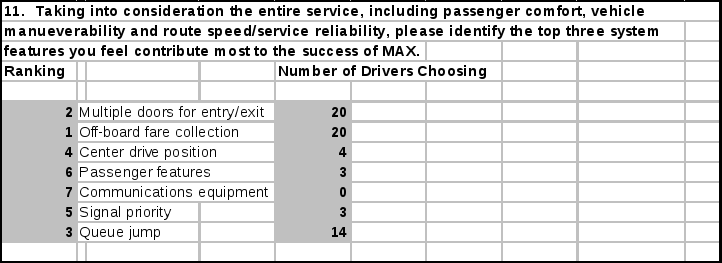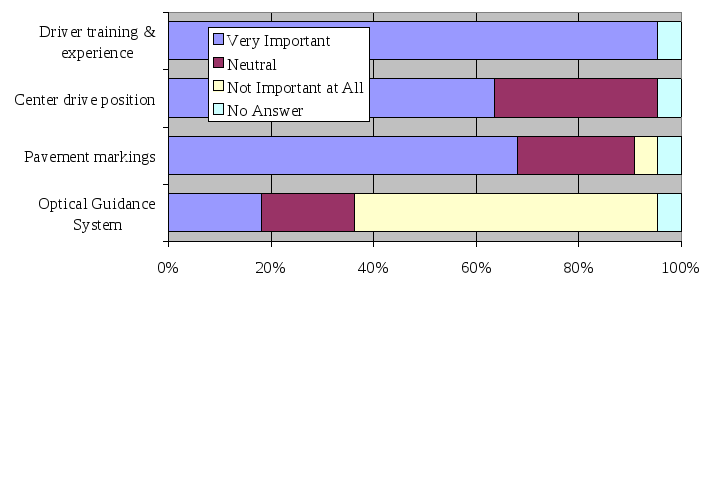
- •2006 Evaluation of the Las Vegas Metropolitan Area Express (max) Bus Rapid Transit Project
- •Max is one of 17 National brt Projects that make up the brt Consortium supported by fta
- •Executive Summary III max Project Fact Sheet VII
- •List of Exhibits 79
- •1.0 Introduction
- •1.1 Evaluation Overview
- •1.2 Max Evaluation Objectives
- •Max evaluation objectives
- •Figure 2-1: max system schematic map
- •2.1 Project and Corridor Description
- •2.2 Running Ways
- •Figure 2-2: More than half of max’s 7.5 mile route is an exclusive curbside bus lane
- •2.3 Stations
- •Figure 2-3: Typical max station (Jerry’s Nugget South)
- •Figure 2-4: Lake Mead station with max ticket vending machine
- •Figure 2-5: Las Vegas Downtown Transportation Center
- •2.4 Vehicles
- •2.5 Fare Collection
- •Figure 2-10: Ticket Vending Machine
- •Figure 2-11: Uniformed security officer checking for fare proof of payment using Personal Digital Assistant
- •2.6 Intelligent Transportation Systems (its)
- •2.7 Service and Operations Plans
- •2.8 Branding and Marketing
- •Figure 2-12: max marketing materials
- •Figure 2-13: Opening Day Celebration
- •3.0 System costs
- •3.1 Capital Costs
- •Table 3-1: Overview of Capital Costs associated with the max service*
- •3.2 Operating Costs
- •Vehicle Operation & Maintenance
- •Table 3-2: max Operating Costs, July 2004 to December 2005
- •4.1 Planning and Design
- •4.2 Vehicle Service, Maintenance and Operations Plan
- •Vehicle Service Plan
- •Vehicle Maintenance
- •Vehicle Operations
- •4.3 Implementation and Management of the its Elements
- •4.4 Branding and Public Acceptance of Service
- •Figure 4-2: Deuce, rtc's new double decker bus, operates on the heavily traveled Las Vegas strip.
- •Table 4-3: Importance of max features in docking the vehicle for precise stops*
- •5.1 Travel Time
- •Table 5-5: Has your travel time changed since riding max?
- •Figure 5-1: Has your travel time changed since riding max? (October 2005)
- •Table 5-6: Rate the speed of travel on max and cat
- •Table 5-7: For riders transferring from other cat/max routes, how long did you wait at the location you transferred? (October 2005)
- •Table 5-8: Rate the Wait Time at max and cat Stations
- •Table 5-9: Dwell Time Model Results
- •5.2 Reliability
- •Table 5-10: Rate the Dependability of max and cat
- •Figure 5-3: Driver Assessment of max features for route speed and reliability compared to cat
- •5.3 Identity and Image
- •Table 5-11: Passenger Rating of Vehicles and Shelters,
- •Max and cat riders
- •Table 5-12: All things considered rating of max and cat by riders of the service
- •Figure 5-4: Overall Rating of max / cat Service (October 2005)
- •Figure 5-5: Survey of cat riders, “Have you ever ridden max?”
- •Table 5-13: Overall rating of max service by cat riders and cat service by max riders
- •Figure 5-6: Survey of cat riders, “Do you prefer to ride cat or max?”
- •5.4 Safety and Security
- •Table 5-14: Rate the Safety of max / cat Vehicle
- •Figure 5-8: Rate the Safety of max Stations / cat Stops (October 2005)
- •5.5 Capacity
- •6.1 Ridership
- •Figure 6-1: Average Boardings per Day, max and 113, January 2004 to July 2006
- •Figure 6-3: Index of Changes in Boardings, lvbn Corridor and Systemwide
- •Table 6-1: Previous mode of max riders
- •Figure 6-4: Previous mode of max riders (October 2005)
- •Table 6-2: Rider ethnicity
- •Figure 6-5: Rider ethnicity
- •Table 6-3: Rider age
- •Figure 6-6: Rider age
- •Table 6-4: Employment status
- •Figure 6-7: Employment status
- •Table 6-5: Rider gender
- •6.2 Capital Cost Effectiveness
- •6.3 Operating Cost Efficiency
- •Figure 6-8: Intensity of Use, max compared to 113
- •Figure 6-9: max Operating Cost per Vehicle Hour
- •Figure 6-10: max Operating Cost per Boarding
- •6.4 Land Use
- •Figure 6-11: Opportunities for Redevelopment: North Las Vegas
- •6.5 Environmental Quality
- •7.1 Max is a success
- •7.2 What Works
- •Table 7-1: Calculation of Time Savings per Trip due to Dwell Time Reduction during Peak (7 am to 7 pm)
- •7.3 Summary of Lessons Learned
- •Vehicle Procurement
- •Its: Traffic Signal Priority and Queue Jumper Technology
- •Brt max Service Questionnaire
Brt max Service Questionnaire
Thank you for taking the time to fill out this survey. We are part of a research team conducting an evaluation of the MAX service for the Federal Transit Administration. We value your opinions and appreciate your assistance with our evaluation.
1. Did you drive vehicles for CAT prior to driving on the MAX route?
Yes
No – I’m a new driver
No – I worked for another ATC operation in another part of the country
2. How long have you been driving for CAT?
Less than 1 year Between 1 year and 3 years
Between 3 and 5 years Between 5 and 10 years
More than 10 years
3. How long have you been driving the CIVIS vehicle on the MAX route?
Since service began – about 2 years
Less than 2 years but more than 1 year
Less than 1 year
4. Do you still sometimes drive CAT routes?
Yes No
5. Generally speaking, do you prefer driving the CIVIS over CAT vehicles?
Yes No Other: ______________________________
6. Please rate how the CIVIS compares with standard CAT vehicles for the following features:
Better Neutral Worse
Driver Comfort/Ride
Passenger Comfort
Vehicle Handling/ Maneuverability
Safety – on road performance
Driver sense of security & safety
Overall Vehicle Performance
7. The CIVIS vehicle has a center drive position. Based on your experience driving from the center position CIVIS vehicle as compared with driving from the left hand position with CAT vehicles, how do the following features rate:
Better Neutral Worse
Forward visibility
Left Side visibility
Right side visibility
Rear visibility
Lining up with curb/platform
General operations
8. How difficult it is to make a stop close to the curb and at the designated door locations?
Very Difficult Neutral Not
Difficult at
All
Challenge of docking vehicle
9. How important are the following features are helping you dock the vehicle and make precision stops?
Very Not
Important Neutral Important
at All
Driver training & experience
Center drive position
Pavement markings
Optical Guidance System
10. How does each of the following MAX features services contribute to route speed and service reliability as compared with standard CAT service:
Improves Reduces
Speed No Speed &
Reliability Effect Reliability
Multiple doors for entry/exit
Off-board fare collection
Passenger accessibility
ADA passenger accessibility
Signal priority at intersections
Queue jump
11. Taking into consideration the entire service, including passenger comfort, vehicle maneuverability and route speed/service reliability, please identify the top three system features you feel contribute most to the success of MAX.
Ranking
Multiple doors for entry/exit ____
Off-board fare collection ____
Center drive position ____
Passenger features ____
Communications equipment ____
Signal priority ____
Queue jump ____






COMPARISON GRAPH

VISIBILITY GRAPH

DOCKING GRAPH

SPEED COMPONENT GRAPH

1 The Evaluation Guidelines for BRT Demonstration Projects can be found at http://www.itsdocs.fhwa.dot.gov//JPODOCS/REPTS_TE//13831.html
CBRT report is available at http://www.gobrt.org/CBRT-DecisionMaking.pdf
2 The other bus system using proof of payment is the Los Angeles Metro Orange Line, which opened in October 2005. Proof of payment is used on many bus systems around the world and on every new light rail system in the U.S. and Canada. It is also used on the Transitway portion of the Ottawa bus system.
3 See RTC, FAST. Transit Signal Priority Implementation Summary Report. June 15, 2005.
4 The data for MAX with TSP off were from Thursday, September 15, 2005 to Saturday, September 24, 2005 (10 days). The data for MAX with TSP in operation were from Tuesday, September 27, 2005 to Monday, October 1, 2005 (7 days).
5 Following the Route 113 schedule for July 2006, we added 7 minutes to the southbound trips to account for the Washington Street to DTC segment, except in the overnight (10 pm to 5 am) period, where we added 6 minutes. For northbound 113 trips, we added 9 minutes for the DTC to Washington segment during the 7 am to 7 pm period, 7 minutes during the overnight period, and 8 minutes at other times. For MAX, following trip data prepared for the October 2006 schedule, we added 9 minutes to account for the DTC to Jerry’s Nugget segment northbound and 8 minutes to account for the same segment southbound, at all times. Note that for both MAX and 113 the south and north routings are different, hence the different travel times. Schedule data were provided by Jacob Simmons of RTC.
6 The week of data was for August 25 to 31, 2006.
7 The previous evaluation of MAX produced for FTA showed travel time savings of 38%- 42% during several time periods. One explanation for the somewhat lower time savings documented here is that the previous study compared MAX to Route 113 prior to MAX service. Many 113 riders changed to MAX when the service became available, and the lower ridership on MAX has possibly resulted in lower dwell times and faster service.
8 RTC conducted on-board passenger surveys in both April and October of 2005. The second survey was conducted to ask additional questions, gauge changes in opinion, and verify the validity of responses to the first survey. Each round of surveys targeted 225 MAX passengers and 225 Route 113 passengers.
9 The calculation of standard deviation of trip times excludes Route 113 trips starting at times when MAX does not operate, namely 10 pm to 5 am.
10 The 2004 benchmark survey had 599 valid respondents interviewed from December 5-17, 2004. The 2005 benchmark survey had a total sample size of 600 Las Vegas Valley residents interviewed from January 16-23, 2006.
11 RTC estimates MAX operating revenues by crediting to MAX all TVM sales of one-ride tickets except those sold at TVMs located on the Strip and by allocating pass revenues based on the percentage of pass usage, as estimated based on the fare payment control counts. As of June 2006, RTC was waiting for a software change to the PDAs used to check fares. RTC expects the change will produce better estimates of use of different fare media.
